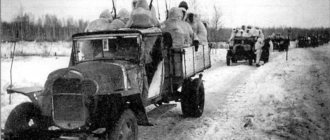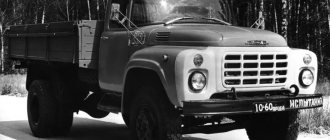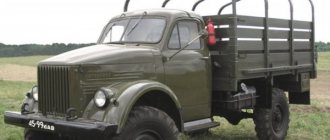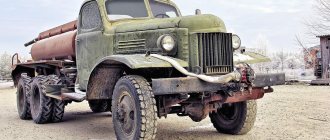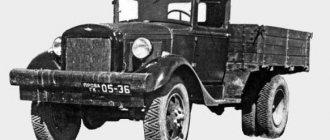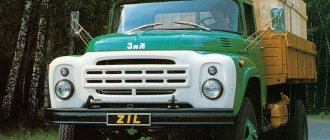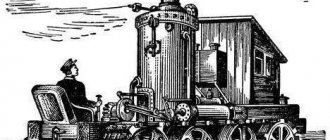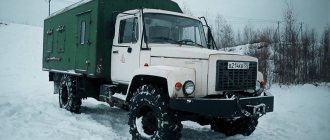The creation of the Gorky Automobile Plant for the production of trucks in Nizhny Novgorod (then Gorky) was not an accident, nor was it mastering the production of the legendary GAZ AA. None of the other industrialized cities had the full amount of advantages of the Volga industrial center. There was already a strong industry here with a large number of experienced workers. The Volga provided abundant water and energy resources and made it possible to transport goods in the cheapest way. There was also a powerful freight railway station here.
This is what a GAZ AA truck looks like
Turning to the services of the Ford concern when organizing the plant and developing the first trucks was quite natural. Our own automobile industry had no experience of such large-scale work, and not a single foreign company could compare with the Detroit Automobile Plant. GAZ-A was copied from the American prototype. For its time, this car was very powerful and high quality.
The engine on the truck and the passenger version was unified and controlled using a four-speed manual transmission.
Some difference from the passenger GAZ-M1 was only a stronger clutch. GAZ-AA had a very low fuel compression ratio. This made it possible to use widespread low-grade fuel (naphtha, low-octane gasoline, lighting kerosene). The release of truly high-quality petroleum products was still ahead.
The loaded truck had a structural weight of just over 1.8 tons, and in normal mode it could carry a load of up to 1,500 kg (this is where the famous expression “lorry and a half” came from). Nevertheless, the acute shortage of truck fleet forced the vehicles to be used as intensively as possible; often 3 tons of cargo were transported in the back of a GAZ-AA at a time.
The production of a full cycle of components in the USSR began in 1933, at the same time GAZ spare parts began to be made exclusively within the country. Starting next year, the truck was equipped with a metal cabin (early versions were made of wood and cardboard). Modernization in 1938 led to the appearance of the GAZ-MM version. Outwardly, this car was indistinguishable from an ordinary “lorry”, but it had a 50-horsepower engine.
It is not difficult to distinguish the engine on the AA and MM modifications; you just need to check the shape of the flange. In the first case, it was rectangular, and in the second, triangular (accordingly, the number of attachment points also differed).
Design of the Gas MM truck
The modernization work did not stop there, however. Opportunities were constantly sought to improve the truck and its engine part. For those who understand engineering, distinguishing the 1938 and 1941 semis will not be difficult.
Advantages and disadvantages
Pros of the car
- High-quality and reliable body metal;
- Good ground clearance;
- Excellent vehicle cross-country ability;
- Small dimensions of the truck;
- There is a windshield wiper (on the driver's side);
- Unpretentiousness in fuel;
- Clear service;
- American roots of Ford;
- The windshield extends;
- Trailers can be transported.
Cons of the car
- There are no hydraulic power steering and brake systems of the car;
- There are no steering wheel and sofa adjustments;
- Ascetic look of the interior;
- Weak power unit;
- Simple and cool cabin;
- Dependent suspension;
- High fuel consumption;
- Low transportable weight;
- Lack of any comfort.
Let's sum it up
Any merger of Russian automobile companies with foreign companies has always benefited the domestic automobile industry, and GAZ-AA is no exception. Its similarity with foreign variations can be seen in the photo. The car turned out to be surprisingly simple, but functional and in demand.
At that time, there were no environmental standards yet, so the fuel consumption of its weak power plant was 20 liters per 100 kilometers. The appearance of the car was very simple, and there was not even a hint of sophistication, because one should not forget the year of its production and the purpose of its release.
It was supposed to serve faithfully on almost all road surfaces. The truck has a good ride height, rear-wheel drive and a payload of 1,500 kg. This was not a record, but in the pre-war period and during the hostilities, the Union of Socialist Republics was in dire need of light-duty vehicles.
Only two people, including the driver, could fit inside the cabin. The interior was also very simple, which once again emphasized the purpose of the car - for work. Russian specialists were able to take the best from the well-known American company, which made it possible to make a successful car.
Decades later, the Gorky Automobile Plant will more than once resort to help and purchase foreign vehicles and spare parts. Today you can find this model from private collectors and in museums.
We advise you to read the article: GAZ - the history of car production.
Design of GAZ-MM
The GAZ-MM car, like its predecessor, was distinguished by a simple design. The vehicle was based on a frame chassis with spring suspension. In those years, most small trucks were assembled according to this scheme. The cabin empennage was taken from a GAZ-A and adapted for a semi-truck.
Description of technical characteristics:
- Length - 5.2 m;
- Width - 2 m;
- Height - 1.9 m;
- Ground clearance - 20 cm;
- Wheelbase - 3.3 m;
- Wheel formula - 4x2;
- Weight - 1.75 t;
- Motor power - 50 hp;
- Maximum speed is 70 km/h.
The main difference from the AA was the new power plant. The GAZ-MM engine has undergone modifications, thanks to which the engineers were able to increase power from 40 to 50 horsepower. The motor remained just as unpretentious. The standard fuel was AI-52 gasoline, but drivers often filled the car with kerosene. Autolyls and nigrols used in industry were used as lubricants. The power unit worked in conjunction with a manual gearbox, which had four stages - three forward and one rear.
The rear suspension and transmission design was unique. The pushing pipe acted as a longitudinal rod. Inside it was a closed driveshaft, which became stronger in the improved model. The main disadvantage of this design was the constant contact of the beam with the bronze bushing. Because of this, the latter quickly lost its quality and failed. The designers also improved the front suspension. They changed the fastening of the jet thrust, resulting in an increase in the operating life. But the increase cannot be called significant: during the war years, the truck was operated with constant overload, which led to fatal breakdowns.
Despite the lack of resources, GAZ-MM and AA became the most popular cars in the pre-war and war years. The number of copies of both models and their varieties produced was just under a million. On the basis of the chassis, many types of special-purpose equipment were assembled, which were used for military and economic purposes. Many technical components were unified when creating new combat vehicles, light tanks, BA-6 and BA-10.
Design features and purpose
The GAZ-AA truck has established itself as having a simple design and high technology for those times. He coped well with moving over rough terrain. The engine power allowed it to reach 70 km/h on the highway with a fuel consumption of 20.5 liters per 100 km.
Important
Almost no non-ferrous metals and alloy steels were used for the car, which significantly reduced its cost. However, parts made of cast iron and low-quality metal had a low wear life.
One of the advantages is the low axial load. When driving in a convoy at minimum speed, the car practically did not destroy the road surface. Medium-tonnage trucks easily passed over bridges with low load-bearing capacity.
GAZ-AA was used to transport goods. Thanks to the huge reserves of power, carriers often exceeded the permissible carrying capacity by two times. The flatbed truck, after installing an awning and benches on the body, began to be used for transporting people.
Before the war, the car found application in all areas of the national economy. During wartime it was used to transport people and goods. Also, military weapons were installed on its frame, for example, the famous Katyushas.
[edit] Links
- GAZ-AA - history of the car
- GAZ-MM
| Moskvich cars | |
| Pre-war | Ford Model A • Ford Model AA • GAZ-AA • KIM-10-50 • KIM-10-51 • KIM-10-52 |
| I generation | Moskvich-400 (422) • Moskvich-401 |
| II generation | Moskvich-402 () • ( • 430 • 411) • (424 • 432) |
| III generation | Moskvich-408 ( • 433 • “Tourist”) • ( • 434) • (2136 • 2733 • 2315) • ( • 2734 • 2140SL) |
| IV generation | Moskvich-2141 (“Svyatogor” • “Yuri Dolgoruky”) • • • • 2142 (2142R5 “Prince Vladimir”) • “Ivan Kalita” (“Duet”) |
| Experienced and experimental | Series 3-5 (3-5-2 • 3-5-3 • 3-5-4 • 3-5-5 • 3-5-6) • Series C (S1 • S2 • S3) • 2143 “Yauza” • 2144 “Istra” • • (416) • • 2139 “Arbat” • A9 • |
| Sports and racing | Moskvich-407 Coupe • Moskvich-412 Rally • Moskvich-404 • G1-405 • G2-407 • G3 • G4 • G5 |
| Trucks, buses and all-terrain vehicles of the Gorky Automobile Plant | |
| GAZ trucks | GAZ-AA • GAZ-MM • GAZ-AAA • GAZ-42 • GAZ-51 • GAZ-62 • GAZ-62 • GAZ-63 • GAZ-52 • GAZ-53 • GAZ-56 • GAZ-66 • GAZ- 3307 • GAZ-3308 “Sadko” • GAZ-33086 “Countryman” • “GAZelle” • “Sobol” • GAZ-3310 “Valdai” • “GAZelle-Business” • Ermak • “GAZelle-Next” • GAZon NEXT |
| GAZ buses | GAZ-03-30 • GAZ-05-193 • GAZ-55 • GZA-651 • “GAZelle” • “GAZelle-Business” • “Sobol” • “GAZelle-Next” |
| GAZ special equipment | GAZ-VM • GAZ-46 • Half-track vehicle based on GAZ-63 • GAZ-47 (GT-S) • GAZ-71 (GT-SM) • GAZ-34039 • GAZ-34039 “Irbis” • GAZ-34039K “Irbis” » • GAZ-3409 “Beaver” • GAZ-3344 • GAZ-3351 • “Tiger” • GAZ-3937 • GAZ-5903 (BTR-80) • GAZ-59039 (BMM-80) • GAZ-5903V “Vetluga” • GAZ-5903Zh • GAZ-59402 “Blizzard” |
What can be concluded?
GAZ-MM is a legendary vehicle that will forever remain in the history of our state. Every celebration of the end of the siege of Leningrad is not complete without mention of this truck, thanks to which it was possible to save the lives of tens of thousands of people. Drawings of the car were not preserved in the archives of the Gorky Automobile Plant. The only surviving copy can be viewed in the Museum of Russian Military History, which is located in the village of Padikovo, Moscow region.
[edit] History
On May 31, 1929, an agreement was signed between the Soviet Union and the American automobile manufacturer to produce a licensed copy of the Ford Model AA. A contract was concluded with the Austin Company for the construction of a plant near Nizhny Novgorod.
In addition to the construction of the plant, the agreement between the USSR provided for the construction of two car assembly plants - in Moscow and Nizhny Novgorod. They planned to assemble cars from ready-made vehicle kits, of which, according to the agreement, the Soviet Union was obliged to purchase 72 thousand. New assembly lines made it possible to assemble cars even before the completion of the plant. Albert Kahn, Inc. was hired to do the work.
In 1929, the first automobile assembly plant was organized on the site of the Gudok Oktyabrya agricultural machinery plant. In February 1930, the assembly of the first Ford-AA cars from ready-made vehicle kits began there. On November 6, the first cars rolled off the main assembly line of the second car assembly plant in Moscow. The situation at the first car assembly plant in Nizhny Novgorod was different:
- The budget allocated for car production turned out to be smaller than expected.
- There was inconsistency in the actions of management structures and disorganization of performers.
In the second half of January 1932, the Nizhny Novgorod plant began producing frame members, crankshafts, cylinder blocks, etc. The cabins of the first non-production cars were assembled from plywood, since there was no regular supply of components, including metal. On January 29, the first cars called “NAZ-AA” rolled off the assembly line. On October 7, Nizhny Novgorod was renamed Gorky, hence the abbreviation for “GAZ,” and by the end of the year, up to 60 cars were being assembled at the plant per day.
In December 1932, GAZ-AA cars took part in a motor rally along the route Nizhny Novgorod - Moscow - Nizhny Novgorod in order to identify weak points in the car's design, and in 1933 - along the route Moscow - Karakum - Moscow. Most of the breakdowns occurred due to low quality components. In 1933, the stock of purchased American vehicle kits ran out, so the production of cars from Soviet components began.
In 1938, cars began to be equipped with a new 50 hp GAZ-M engine, which appeared in 1936. At the same time, the steering mechanism and rear spring mountings were modernized. The updated cars were called “GAZ-MM” (there is a misconception that these cars differed in appearance from “AA”). In October 1940, a new towing device and a new spare tire mounting system began to be installed on the car.
The Great Patriotic War
During the Great Patriotic War, the “lorry” was one of the main military vehicles in the ranks of the Red Army. GAZ-AA performed various functions: transporting military personnel, ammunition, food, equipment, etc.
With the beginning of the war, the appearance of the car changed. Metal was saved, so the wings were made of simple roofing iron, and the doors and roof were made of canvas. One headlight and wiper were installed only on the driver's side; the bumper, muffler and front brakes were missing. In 1943, the canvas doors were replaced with wide wooden ones.
Army photos on Shutterstock: Army and military photos.
The car played a big role during the Leningrad blockade, delivering everything necessary for existence to the residents of Leningrad. Nazi troops blocked the city, cutting off all land routes to it. It was possible to enter Leningrad only through Lake Ladoga. On November 22, 1941, the first “one and a half” trucks came out onto the frozen pond. The road they walked along was officially called Military Highway No. 101, unofficially - the Road of Life. This route was closed on April 21, 1942. In total, in 1941-1942, GAZ-AA and GAZ-MM transported 361,109 tons of cargo, including 262,419 tons of food. On the way back from Leningrad, residents were evacuated.
Post-war years
After the war, production of the GAZ-MM continued; the bumper, muffler, two headlights, metal doors and front brakes were returned to the car. A window was made in the rear wall of the cabin. At the Gorky Automobile Plant, the last car rolled off the assembly line on October 10, 1949, and at the UlZIS (Ulyanovsk Automobile Plant) in 1950. In total, about 800,000-1,000,000 copies were produced; during the war, GAZ assembled about 102,300 trucks. By the beginning of the war, there were 151,100 vehicles in the ranks of the Red Army.
A little more history
Already at the end of 1932 (when production of GAZ-AA began), daily production reached 60 cars. It must be said that quite significant changes were made to the original Ford design. Thus, the steering mechanism became stronger and an oil filter appeared. The body was actually redesigned. A frame chassis with sprung suspension was used as the basis. Soon enough it was discovered that this design wears out very quickly and severely. And if you also take into account the widespread overload at that time (a rare semi-truck was not constantly loaded more than normal), the frequency of breakdowns is quite understandable.
Overall dimensions of the GAZ AA truck
Mechanical brakes were of catastrophically poor quality, so drivers tried to slow down by shifting gears. On the GAZ-AA, due to the location of the gas tank above the carburetor, gasoline was supplied by gravity. The transmission was based on a dry clutch. Since the semi-truck was quite light, it was used on the Road of Life, calmly passing where heavier trucks would have sunk. She transported more than 360,000 tons of cargo, including 262,000 tons of food. On return flights they always tried to take city residents.
This is what a Gas AA carburetor looks like.
If you look at the factory drawings and then at the wartime products, it becomes clear that they are very simplified. They abandoned stamped wings and started using welded ones. Not only was the right headlight missing, but also the front bumper. The body could only be opened from the rear. From the beginning of 1942, the use of a very simplified cabin began, and from 1943, a closed wooden one.
Guest from overseas
The first five-year plan (1928-1932) was underway in the USSR, the tasks of which were completed ahead of schedule - in four years. The country adopted a plan for the rapid development of all spheres of society and the creation of a powerful industrial power. Over 1,500 different industrial and production facilities were built and developed throughout the country. To accomplish this large-scale and ambitious task, a large mass of trucks of all types was required, the “workhorses” of rapid industrialization.
Ford-AA
The Soviet Union was dependent on foreign supplies of cars, but especially on expensive spare parts for them. The need for our own full-fledged production lines was increasingly felt. And soon they began to appear.
It was decided, in collaboration with American engineers from Albert Kahn Inc., to build an auto giant near Nizhny Novgorod, which, according to the plan, was to produce up to 100 thousand trucks per year. There weren’t very many options to choose from: AM General did not agree to cooperate with the USSR, but another auto giant, Ford, offered its services. The company itself was then undergoing modernization, and Ford's generation T cars were replaced by new ones - A and AA. Just Ford AA. It met all the requirements, which is why it was chosen as a sample. The new truck carried one and a half tons of cargo on board, was simple, reliable and unpretentious, and most importantly, our engineers developed their own version of the vehicle and made adjustments to further simplify the design, but with a multiple increase in its reliability.
Main modifications based on GAZ-AA and GAZ-MM:
GAZ-AAA
— six-wheeled (three-axle with a 6x4 wheel arrangement) off-road truck, payload capacity 2.0 tons. Created on the basis of a licensed Ford-Timken truck of the 1931 model. Years of production: 1934—1943. In 1937, it received a more powerful 50-horsepower engine and other components from GAZ-MM. The total output until 1943 was 37,373 units. On the basis of GAZ-AAA, the GAZ-05-193 headquarters bus (1936-1945), as well as serial armored vehicles BA-6 (1936-1938, 394 units), BA-10A (1938-1939) and BA-10M ( 1939-1941, a total of 3331 units). At the end of the 1930s, the armored hulls of the armored vehicles of the early series that had exhausted their service life were rearranged onto the shortened GAZ-AAA chassis, thus the armored vehicles BA-27M (1937-1938), BAI-M and BAI-3M (1939-1940) were obtained. In addition, experimental BA-6 m and BA-9 were created; experimental amphibious armored vehicles PB-4 (1933-1934, 6 units) and PB-7 (1936/37, 1 unit). The BKhM-1 chemical combat vehicle was produced (1935-1937), and an experimental ambulance BA-22 armored personnel carrier for 10 wounded was created (1937). BA-10 - in the fall of 1941 - in the spring of 1942, the remaining batch of BA-10M armored hulls remaining at the Izhora plant was delivered to the GAZ-MM two-axle chassis. These armored vehicles were delivered only to the Leningrad Front.
GAZ-410
— dump truck on GAZ-AA and GAZ-MM chassis, load capacity 1.2 tons, all-metal body of self-unloading type. Years of production: 1934—1946.
GAZ-42
- a gas generator modification that used wooden lumps as fuel. The engine power is 35-38 hp, the rated load capacity is 1.0 tons (the actual one is less, since a significant part of the shortened platform was occupied by a 150-200 kg supply of lumps). Years of production: 1938—1950.
GAZ-43
— gas generator version using coal. It was distinguished by the smaller dimensions of the gas generator installation. Produced in small quantities in 1938-1941.
GAZ-44
— gas-cylinder version using compressed gas. Gas cylinders were located under the cargo platform. Produced in a small batch in 1939. The first production cars were equipped with a NATI-SG6 gearbox, which was later replaced by a NATI-SG19 gearbox. The double-diaphragm reducer NATI-SG19 was more compact than the single-diaphragm NATI-SG6. All equipment was located under the engine hood. The gearbox was placed above the engine, which gave it sufficient heating to prevent freezing. To monitor the gas reserve indicator in the cylinders, a pressure gauge was placed on the lining of the front beam of the cabin. 60 cubic meters of compressed gas were stored in six cylinders. The weight of the gas installation was 420 kg. Gas equipment was produced by the Kuibyshev Carburetor Plant. The average mileage of a car without replenishing gas reserves depended on the fuel and was: 150 km with coke oven gas and lamp gas, 200 with synthesis gas, 300 with methane.
NATI-3
— an experimental half-track modification with a rubber-metal track with sloth drive from a standard axle. Tested in 1934-1936.
GAZ-60
- serial half-track modification with a rubber-metal track with sloth drive from a standard axle. Years of production: 1938—1943.
GAZ-65
— an all-terrain modification with a tracked-wheel drive driven by standard rear wheels. In 1940, an experimental industrial batch was produced, which showed the complete unsuitability of this scheme for the conditions of actual vehicle operation, both in the front and later in the rear (fuel consumption exceeded 60 l/100 km).
GAZ-03-30
— 17-seater general purpose bus with a body on a wooden frame with metal cladding. Produced at the facilities of GAZ's related company - GZA (Gorky Bus Plant, formerly). Years of production: 1933-1950, with a break in 1942-1945. The most common model of the Soviet bus of the pre-war period.
GAZ-55 (M-55)
- ambulance, equipped with rear axle shock absorbers. Capacity: 10 people, including four on stretchers. Years of production: 1938—1945. The most popular ambulance of the Red Army during the Second World War.
PMG-1
- fire truck (linear). Years of production: 1932—1941 (?). The most popular pre-war fire truck in the USSR, in fact, the real motorization of fire fighting in our country began with this fire truck.
Based on materials from the sites 66.ru, anaga.ru
Modifications
A modernized version of the “Lorry” with a more powerful 50 horsepower engine, a new cardan, steering and reinforced suspension. Produced from 1938 to 1950.
A simplified version of the “Lorry”. The doors were replaced with triangular side barriers and roll-up canvas doors, the fenders were made of roofing iron using a simple bending method, there were no brakes on the front wheels, only one headlight was left, and the side walls did not fold down.
GAZ-AAA
An off-road truck with a 6x4 wheel arrangement and a load capacity of 2 tons. Produced from '34 to '43. 37,373 cars were produced, that's a fun number! At its base, both staff buses and military equipment were produced - armored vehicles, chemical combat vehicles and armored personnel carriers.
GAZ-410
A dump truck on a GAZ-AA chassis with an all-metal body and a lower load capacity of 1.2 tons. Produced from 34 to 46 years.
GAZ-42
The truck, with a gas generator unit, built on the basis of the “Lorry”, ran on solid fuel and literally drove on firewood. The engine power was 35-38 horsepower, and the load capacity without firewood was 1 ton, with a full load of wood just over 800 kg.
GAZ-43
The car, like the GAZ-42, ran on solid fuel, but coal was used instead of firewood. The gas generating unit was smaller in size. Years of production: 1938 – 1941.
GAZ-44
Modification with a gas cylinder installation, liquefied petroleum gas was used as fuel. Produced in 1939.
GAZ-55
Produced in 12,044 copies, the Soviet ambulance bus is based on a GAZ-MM chassis. Serial production was organized in 1938 at the Gorky Automobile Assembly Plant (since 1940, a GAZ bus branch). In 1942, the design of the machine was significantly simplified. The front fenders were no longer made using the deep stamping method, but just as on the GAZ-MM-V they were bent from a flat sheet, the rear mudguards were made in a similar way, only the left headlight was installed, there were no front brakes.
Production of the GAZ-55 continued after the war. Discontinued at the end of 1950
GAZ-60
Half-track off-road truck. Produced from 1938 to 1943 in small batches. In total, just over 1,000 copies of the GAZ-60 and its modifications were produced.
GAZ-65
Tracked-wheeled modification of GAZ-AA. Tracks were placed on the standard rear wheels, and these rear wheels drove the car. In 1940, a pilot batch of about 2,000 copies was produced. The design turned out to be unsuccessful and was never returned to. Experience in the design, testing and operation of such vehicles has shown that the creation of half-tracks on the basis of standard vehicles led to their extremely low durability, since when installing a caterpillar drive, all other units remained unchanged, and due to the increase in the load-bearing capacity of the propulsion unit, they worked with large overloads. Frequent breakdowns and structural failures were typical of half-track operation.
GAZ-03-30
A civilian bus on a GAZ-AA chassis designed for 17 passengers. The body frame was made of wood with metal cladding. The most common bus model of the pre-war era. Years of production 1933-1950
PMG-1
The Gorky Automobile Plant produced the first fire trucks on the AMO-F15 chassis back in 1926. In order to turn the “Lorry” into a fire truck, the first step was to remove the driveshaft and driver’s seat from it. A transfer case was installed behind the gearbox, and a D-20 centrifugal pump was installed in the rear of the car. The lower output shank of the transfer case was connected by a driveshaft to the main gear, and the upper one was connected to the pump.
A wooden superstructure with side seats for the fire brigade was installed on the chassis. It contained a tank of water for providing first aid in case of fire. On the sides, reels with folding sleeves were attached to the backs of the seats. A three-legged retractable ladder, pick-up sleeves, a spare wheel and rubber trunks were fixed on top of the superstructure, inside the superstructure there was a stander and a bat lantern, and in its drawers there were various fire-fighting accessories (a tee splitter, pick-up nets, etc.) and entrenching tool. A foam generator, a double splitter and two fire extinguishers were attached to the front fenders, and swivel brackets were attached to the rear of the car, on which a large reel with folding sleeves was suspended. To control the machine when supplying water during a fire, appropriate rods were placed inside the superstructure, and control handles were installed in its rear part.
Technical characteristics of GAZ-AA:
| Engine | gasoline, carburetor, 4-stroke, lower valve |
| Number of cylinders | 4 |
| Working volume, cm3 | 3285 |
| Max. power, hp/rpm | 40/2200 |
| Max. torque, kgf*m (Nm) | 15,5 (152) |
| Drive unit | rear |
| Transmission | manual, 4-speed, not synchronized |
| Front suspension | dependent, on a transverse semi-elliptical spring with push rods |
| Rear suspension | dependent, on two longitudinal cantilever springs, without shock absorbers |
| Front brakes | drums |
| Rear brakes | drums |
| Maximum speed, km/h | 70 |
| Acceleration time 0-100 km/h, sec. | — |
| Dimensions, mm | . |
| length | 5335 |
| width | 2040 |
| height | 1970 |
| wheelbase | 3340 |
| ground clearance | 200 |
| Curb weight, kg | 1810 |
| Tires, inches | 6.50 – 20 |
| Load capacity, kg | 1500 |
| Fuel consumption, l/100 km | mixed cycle 20.5 |
| Fuel tank capacity, l | 40 |
GAZ-66 - "Shishiga"
This truck with a payload capacity of 2 tons was specially created to drive where no other vehicle can go. All-wheel drive and excellent cross-country ability made this truck practically the main transport of the Soviet Army. A distinctive feature of the “shishiga” is the balanced location of the center of gravity, which gave an almost equal distribution of load between the front and rear axles. The car was popular among the airborne troops - when landing with a parachute, the car descends without blocking the cabin and lands on all wheels at once. True, the truck also had significant shortcomings. The size and location of the cabin turned out to be dangerous for the crew of the vehicle in the event of a mine explosion. For this reason, the GAZ-66, starting in the 1980s, was withdrawn from combat units in Afghanistan.
The first production car was produced in 1964, although prototypes of the GAZ-66 were ready back in 1957, but due to the lack of an engine suitable for power, production had to be postponed. The last car left the assembly shop on July 1, 1999, and was replaced by the GAZ-3308 Sadko. In total, during the production of GAZ-66, 965,941 cars were produced.
The GAZ-66 was equipped with a V-shaped carburetor engine ZMZ-513 with a volume of 4.3 liters and a power of 125 hp. The maximum speed of the truck is 70 km/h, fuel consumption is 18 liters per 100 km.
Control mechanisms GAZ-AA and GAZ-MM
The steering mechanisms of the GAZ-AA and GAZ-MM cars were a pair of “worm and sector with two teeth.” The steering gear ratio, 16.6, is typically “passenger-grade.”
The steering gearboxes of the pre-war GAZ-M1 and the first Pobeda had the same relationship. To be fair, it should be noted that, due to its weight distribution, the weight on the front axle of the semi-truck was always less than that of the Pobeda.
So, with their own weight, the front wheels of the compared vehicles accounted for: a truck with 730 kg, and a passenger car with 740 kg. At full load, the same compared parameters were 835 and 880 kg, respectively. But on Pobeda, already in 1950, the gearbox was increased to a ratio of 18.2.
The brake systems of the lorry, like all domestic pre-war vehicles, are with a mechanical lever-cable drive.
In the working brake systems of the GAZ-AA and GAZ-MM vehicles, the same pad and drum sizes were used for the front and rear wheels. Interchangeability “in a circle” is an absolute good, but only when it does not contradict elementary logic and common sense.
It should be obvious to everyone that a two-axle truck has dual rear wheels, and the rear brakes should be more effective. The load on the rear axle is always higher, and the rear dual ramps, in terms of their total weight and total area of contact with the road, are always more resistant to stopping.
On the post-war “lawns”, starting with the GAZ-51 cars, when technological, production and financial opportunities for “variations on the theme” appeared, the rear brake mechanisms, in comparison with the front ones, were significantly strengthened. So, for the front wheels, the diameter of the brake drums was 355 mm, the width of the pads was 60 mm, and the diameter of the working cylinders was 35 mm. For the rear wheels of the GAZ-51, the same dimensions were 380, 80, and 38 mm, respectively. What were the Americans thinking when they installed identical drums with a diameter of 355 mm and identical pads with a width of 63 mm on the front and rear axles of their Ford AA trucks?
The lorry's belt drum parking braking mechanisms acted on the rear wheels.
History has left us no information about how effective or trouble-free they were. However, taking into account everything that has been said about the size of the rear brake pads, it can hardly be doubted that the handbrake was an additional and unique booster for the rear brakes, both during service and emergency braking. Otherwise, the axiom that the lorry’s brakes left much to be desired could not but be confirmed. And therefore, the drivers of these cars were perhaps the most disciplined and careful on the roads - life obliged...
Truck design
The experience gained during the war and familiarity with the latest models of captured and allied cargo vehicles from the leading automotive powers of the world allowed Soviet developers to create a simple but very functional vehicle based on an optimal hood layout. With a relatively short wheelbase, the engine and cab moved forward made it possible to install a fairly long and spacious cargo platform.
The truck's frame was a simple "ladder" structure, in which two long side members were connected to each other using five cross beams. The cabin and body, suspension and power unit were attached to the frame. The body platform was connected to the frame using stepladders. To transport large light loads, special slots were provided in the side frame of the body for extending the sides.
Frame and rear axle
For the first time in the Soviet automobile industry, the design of the GAZ-51 solved the problem of ensuring equal strength of all systems and components of the vehicle. Also, for the first time, such modern solutions at that time as an aluminum cylinder head, inserted valve seats, adjustable mixture heating, an oil cooler and double oil filtration, closed crankcase ventilation, thin-walled bimetallic crankshaft liners and easily removable brake drums were successfully tested. In terms of technology, the use of new wear-resistant types of cast iron and chrome plating of a number of important parts were mastered.
For the post-war production of the GAZ-51, the engine was significantly improved, which made it possible to significantly improve its technical characteristics. In the design of trucks, a hydraulic brake cylinder was used, which became much more effective than mechanical brakes. At the same time, the vehicle's own weight steadily decreased during periodic improvements, amounting to just under 2.3 tons by 1962.
The truck's cabin had modern outlines for those years and was consistently improved. On the first production cars, the cabin roof and doorways were lined with wood, and the top was covered with plywood and tarpaulin. Soon, door frames and a number of other parts of the cabin began to be made from metal. After 1955, it became all-metal, and a year later a heating system appeared in it. For ventilation in hot weather, the windshields could be raised to an almost horizontal position. A windshield wiper was installed on the driver's side.
Engine GAZ-51
Vehicle modifications and options
In addition to the GAZ-MM truck, which became a natural continuation of the original model, other modifications of the lorry were also produced:
- GAZ-42 and GAZ-43 are gas-generating versions of the truck that appeared simultaneously with the GAZ-MM. These two options differed in the type of fuel: GAZ-43 ran on coal, and GAZ-42 ran on ordinary wood;
- GAZ-44. This car received gas equipment. The fuel could be methane, lighting gas or coke oven gas. Such machines were built only in 1939;
- GAZ-60. Half-track off-road truck. Produced from 1938 to 1943;
- GAZ-AAA is a three-axle modification. Two pairs of wheels were driving, which increased the vehicle's maneuverability. The carrying capacity has also increased (up to two tons). These trucks were produced from 1934 to 1943.
Separate mention should be made of the GAZ-410 car, serial production of which began in 1936. Initially it was called GAZ-S1 - the letter “C”, according to some sources, stood for “Sverdlov”.
In fact, this vehicle, made on the basis of the GAZ-AA, is the first Soviet dump truck. The car did not have a mechanism for tipping the body - instead it used gravity. The driver just had to turn the locking lever and unlock the cargo platform, which then tilted back. The empty body, on the contrary, returned to its original position under the influence of its own weight.
In addition, GAZ-03-30 buses (number of passengers - 17) were manufactured on the basis of GAZ-AA. Their production was carried out at the same assembly plant that was originally created for the assembly of American vehicle kits.
In the army, the “one and a half” mastered many different “professions”. The most successful military modification was the M-55 (or GAZ-55) ambulance. This vehicle was used during the war almost as widely as a regular truck. The “lorry” was also used as a mobile radio station, an anti-chemical laboratory, a mobile power station and a searchlight installation.
Appearance
Since the fall of 1940, they began to install a powerful towing device on it along with fittings for mounting a spare wheel of a different mechanism. The material of the car was changed as soon as the Great Patriotic War began. If we talk about metal, then they began to save it, therefore the front part eventually lost all the parts that were not considered urgently needed.
The wings, which were angular, began to be bent from roofing iron, and the roof, along with the doors, was made using tarpaulin. They decided to install the headlight, along with the wiper, only on the driver’s side, and the front brakes, along with the muffler and bumper, were not installed at all.
Beginning in 1943, the canvas flaps on the side parts of the cabin began to be replaced with wide wooden doors. A simplified modification of the GAZ-MM continued to be produced even after the end of hostilities, but the cars received full metal doors, mufflers, front brakes, a bumper and a pair of headlights.
The tarpaulin of the rear wall of the cabin had a rectangular window. This is clearly visible in the photo. GAZ-AA was a fairly simple, but successful and technologically advanced truck, which was not picky and could not run on the highest quality fuel.
The front of the Lawn was fairly simple. There was a simple bumper, a pair of headlights and a large rectangular radiator grille. Two front lighting lamps were mounted on the wheel fenders and the front hood. An audible signal was installed under one of the lamps.
The hood lids opened like gull wings, providing convenient free space for repairing the power unit. Nearby there was a fuel tank designed for 40 liters. The spare wheel was located under the frame at the rear of the chassis. The side part was occupied by a door with smooth wheel fenders and a comfortable footrest.
Also, the wooden body smoothly transitioned from the side to the rear. The side and rear sides were folding. Also on the back of the vehicle, on the left side, rear lighting could be found.
Peculiarities of operation of the "lorry" during the war years
Even in the pre-war years, the GAZ-AA became the most popular Soviet truck and the main vehicle of the Red Army. The simplicity of the device, which made it possible, if necessary, to carry out repairs even in the most difficult conditions, the extreme ease of maintenance and structural strength made this vehicle ideal for use in the army.
By June 22, 1941, the total number of military lorries was more than 151 thousand.
Front-line operation showed that the design of the vehicle contained significant reserves. Sometimes GAZ-AA managed to transport three tons, that is, twice the “passport” carrying capacity. The vehicle's cross-country ability also turned out to be quite acceptable, and where it was not enough, its special modifications could be used. The vehicle was used on all fronts, and throughout the war the “lorry” established itself as one of the most reliable vehicles.
GAZ-AA played a very special role in saving the starving residents of Leningrad, surrounded by German and Finnish troops. As you know, the only way to deliver food to the blockaded city was transportation along the “Road of Life”, laid on the ice of Lake Ladoga. Despite the harsh winter, not every truck could make it this way. The small and relatively light “lorry” became a real salvation in this tragic situation.
Every night throughout the winter of 1941-1942, GAZ-AA drivers made four, sometimes six trips, delivering food and medicine to Leningrad. “Lorry” trucks at this time ceased to even be perceived as ordinary soulless cars; they turned into a symbol of saving human lives.
"Lorry" on the way to blockaded Leningrad
Development and production
In record time, in collaboration with engineers from Albert Kahn and Austin Co. By the beginning of 1932, a new Soviet auto giant had grown up in the USSR near Nizhny Novgorod (near the village of Monastyri). In October of the same year, the city was renamed Gorky, and the car received the familiar designation GA3. The workers mastered the assembly process, and by that time the personnel at the plant were already quite qualified. By the end of 1932, the plant was assembling 60 trucks per day! And since 1933, the car became completely domestic, assembled only from Soviet components and did not require any foreign supplies.
Year after year, the process of improving the lorry went on. So, in 1938, the GAZ-MM appeared, boosted to 50 hp. engine and many modifications that made the car even more reliable. Special attention should be paid to modifications. Experts find over 50 options: this is the most popular bus of the 30s in our country, a fire truck, a tank, and an airfield vehicle. Armored vehicles were also produced on the GAZ-AA basis.
Fire "ruler"
With the advent of the “Lorry”, an inexpensive mass-produced truck, motorization of the fire service became possible. At the Miussky Fire Engine Plant, founded in Moscow in 1919, a fire engine was assembled on a GAZ-AA chassis. For conversion, trucks from the KIM assembly line were driven under their own power. They differed from the basic “extinguisher” by the presence of a power take-off, thanks to which the pump that pumped water worked. The name “line” comes from a special wooden body, with benches for the fire brigade and a water tank.
Russian coin "Leningrad" with an image of a lorry breaking a blockade across a lake. Photo: Commons.wikimedia.org
